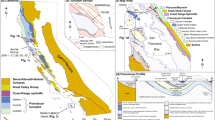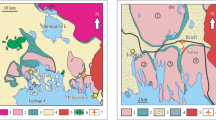Abstract
Pressure-temperature conditions of metamorphism in the Yanai district, Ryoke belt, SW Japan, have been determined using garnet-biotite thermometry in combination with an empirically calibrated barometer in the assemblage common in pelitic and siliceous rocks, garnet + biotite + plagioclase + quartz. The barometer estimates pressure difference between a well-established sample and unknown samples based on the reaction,
Pressure and pressure gradient increased with increasing temperature such that pressures of high-grade areas exceeded that of the triple point of aluminosilicates. The thermobaric structure of the study area shows that pressure increased up to 5 kbar with southward increase in metamorphic temperature up to the highest-grade area, the garnet-cordierite zone. Further south, pressure was almost the same as that of the garnet-cordierite zone and temperature decreased. This asymmetric distribution of metamorphic conditions on both sides of the garnet-cordierite zone can explain the asymmetric distribution of metamorphic zones; the K-feldspar-cordierite zone and sillimanite-K-feldspar zone on the north and south sides of the garnet-cordierite zone, respectively. The breakdown reaction of muscovite and quartz defines the beginning of both the K-feldspar-cordierite zone and sillimanite-K-feldspar zone, which took place under low and high pressures, respectively. These thermobaric structures suggest that temperature varied laterally at mid-crustal level during the peak of metamorphism.








Similar content being viewed by others
References
Banno S, Nakajima T (1992) Metamorphic belts of Japanese islands. Ann Rev Earth Planet Sci 20:159–179
Barrow G (1893) On an intrusion of muscovite-biotite gneiss in the southeastern Highlands of Scotland, and its accompanying metamorphism. Quart J Geol Soc London 49:330–358
Barrow G (1912) On the geology of lower Dee-side and the southern Highland Border. Proc Geol Assoc London 23:274–290
Beppu M, Furukawa N, Hiroi Y (2002) Spinel-producing partial melting reaction in pelitic gneisses: petrographical and synthetic experimental approach. Jpn Mag Mineral Petrol Sci 31:97–110 (in Japanese with English abstract)
Bohlen SR, Montana A, Kerrick DM (1991) Precise determination of the equilibria kyanite=sillimanite and kyanite=andalusite and a revised triple point for Al2SiO5 polymorphs. Am Mineral 76:677–680
Brown M (1998) Unpairing metamorphic belts: P-T paths and a tectonic model for the Ryoke Belt, southwest Japan. J Metamorphic Geol 16:3–22
Chatterjee ND, Johannes W (1974) Thermal stability and standard thermodynamic properties of synthetic 2M1-muscovite, KAl2[AlSi3O10 (OH)2]. Contrib Mineral Petrol 48:89–114
Chinner GA (1966) The distribution of pressure and temperature during Dalradian metamorphism. Quart J Geol Soc London 122:159–186
Ferry JM, Spear FS (1978) Experimental calibration of the partitioning of Fe and Mg between biotite and garnet. Contrib Mineral Petrol 66:113–117
Ganguly J, Kennedy GC (1974) The energetics of natural garnet solid solution I. Mixing of the aluminosilicate end-members. Contrib Mineral Petrol 48:137–148
Ghent ED (1976) Plagioclase-garnet-Al2SiO5-quartz: a potential geobarometer—geothermometer. Am Mineral 61:710–714
Higashimoto S, Nureki T, Hara I, Tsukuda E, Nakajima T (1983) Geology of the Iwakuni district. Quadrangle Ser 1:50,000, Geol Surv Jpn (in Japanese with English abstract)
Higashimoto S, Takahashi Y, Makimoto H, Wakita K, Tsukuda E (1986) Geology of the Otake district. Quadrangle Ser 1:50,000 Geol Surv Jpn (in Japanese with English abstract)
Hodges KV, Spear FS (1982) Geothermometry, geobarometry and the Al2SiO5 triple point at Mt. Moosilauke, New Hampshire. Am Mineral 67:1118–1134
Hoisch TD (1990) Empirical calibration of six geobarometers for the mineral assemblage quartz + muscovite + biotite + plagioclase + garnet. Contrib Mineral Petrol 104:225–234
Hokada T (1998) Phase relations and P-T conditions of the Ryoke pelitic and psammitic metamorphic rocks in the Ina district, central Japan. Isl Arc 7:609–620
Holdaway MJ (1971) Stability of andalusite and the aluminum silicate phase diagram. Am J Sci 271:97–131
Holland TJB, Powell R (1990) An enlarged and updated internally consistent thermodynamic dataset with uncertainties and correlations: the system K2O-Na2O-CaO-MgO-MnO-FeO-Fe2O3-Al2O3-TiO2-SiO2-C-H2-O2. J Metamorphic Geol 8:89–124
Holland TJB, Powell R (1998) An internally consistent thermodynamic data set for phases of petrological interest. J Metamorphic Geol 16:309–343
Ikeda T (1991) Heterogeneous biotite from Ryoke metamorphic rocks in the Yanai district, southwest Japan. J Geol Soc Jpn 97:537–547
Ikeda T (1993) Compositional zoning patterns of garnet during prograde metamorphism from the Yanai district, Ryoke metamorphic belt, southwest Japan. Lithos 30:109–121
Ikeda T (1998a) Progressive sequence of reactions of the Ryoke metamorphism in the Yanai district, southwest Japan: the formation of cordierite. J Metamorphic Geol 16:39–52
Ikeda T (1998b) Phase equilibria and the pressure-temperature path of the highest-grade Ryoke metamorphic rocks in the Yanai district, SW Japan. Contrib Mineral Petrol 132:321–335
Ikeda T (2002) Regional occurrence of orthopyroxene-bearing basic rocks in the Yanai district, southwest Japan: evidence for granulite-facies Ryoke metamorphism. Isl Arc 11:185–192
Kawakami T (2001) Tourmaline breakdown in the migmatite zone of the Ryoke metamorphic belt, SW Japan. J Metamorphic Geol 19:61–75
Kawakami T, Ikeda T (2003) Boron in metapelites controlled by the breakdown of tourmaline and retrograde formation of borosilicates in the Yanai area, Ryoke metamorphic belt, SW Japan. Contrib Mineral Petrol 145:131–150
Koziol AM, Newton RC (1988) Redetermination of the anorthite breakdown reaction and improvement of the plagioclase-garnet-Al2SiO5-quartz geobarometer. Am Mineral 73:216–223
Miyashiro A (1961) Evolution of metamorphic belts. J Petrol 2:277–311
Miyashiro A (1994) Metamorphic Petrology. UCL Press
Morikiyo T (1986) Hydrogen and carbon isotope studies on the graphite-bearing metapelites in the northern Kiso district of central Japan. Contrib Mineral Petrol 94:165–177
Nakajima T (1994) The Ryoke plutonometamorphic belt: crustal section of the Cretaceous Eurasian continental margin. Lithos 33:51–66
Newton RC, Haselton HT (1981) Thermodynamics of the garnet-plagioclase- Al2SiO5-quartz geobarometer. In: Newton RC (ed) Thermodynamics of minerals and melts. Springer, Berlin Heidelberg New York, pp 131–147
Nureki T (1974) Contact metamorphism in the So-o district, Yamaguchi Prefecture, Japan -- with special reference to the occurrence of sillimanite. Mem Geol Soc Jpn 11:251–281
Okudaira T (1996a) Temperature-time path for the low-pressure Ryoke metamorphism, Japan, based on chemical zoning in garnet. J Metamorphic Geol 14:427–440
Okudaira T (1996b) Thermal evolution of the Ryoke metamorphic belt, southwestern Japan: tectonic and numerical modeling. Isl Arc 5:373–385
Okudaira T, Hara I, Sakurai Y, Hayasaka Y (1993) Tectono-metamorphic processes of the Ryoke belt in the Iwakuni-Yanai district, southwest Japan. Mem Geol Soc Jpn 42:91–120
Ono A (1977) Temperature and pressure of the Ryoke gneisses estimated by garnet-cordierite geothermometer. J Jpn Assoc Min Petr Econ Geol 72:114–117
Pattison DRM (1992) Stability of andalusite and sillimanite and the Al2SiO5 triple point: constraints from the Ballachulish aureole, Scotland. J Geol 100:423–446
Pattison DRM, Tracy RJ (1991) Phase equilibria and thermobarometry of metapelites. In: Kerrick DM (ed) Contact metamorphism. (Reviews in mineralogy, 26) Mineral Soc Am, Washington, DC, pp 105–206
Spear FS, Cheney JT (1989) A petrogenetic grid for pelitic schists in the system SiO2- Al2O3-FeO-MgO-K2O-H2O. Contrib Mineral Petrol 101:149–164
Suzuki K, Adachi M (1998) Denudation history of the high T/P Ryoke metamorphic belt, southwest Japan: constraints from CHIME monazite ages of gneisses and granitoids. J Metamorphic Geol 16:23–37
Suzuki K, Adachi M, Nureki T (1996) CHIME age dating of monazites from metamorphic rocks and granitic rocks of the Ryoke belt in the Iwakuni area, Southwest Japan. Isl Arc 5:43–55
Symmes GH, Ferry JM (1992) The effect of whole-rock MnO content on the stability of garnet in pelitic schists during metamorphism. J Metamorphic Geol 10:221–237
Takami M, Isozaki Y, Nishimura Y, Itaya T (1993) Effect of detrital white mica and contact metamorphism to K-Ar dating of weakly metamorphosed accretionary complex: an example of Jurassic accretionary complex in eastern Yamaguchi Prefecture, southwest Japan (in Japanese with English abstract). J Geol Soc Jpn 99:545–563
Thompson AB (1974) Calculation of muscovite-paragonite-alkali feldspar phase relations. Contrib Mineral Petrol 44:173–194
Tilley CE (1925) A preliminary survey of metamorphic zones in the southern Highlands of Scotland. Quart J Geol Soc London 81:100–112
Vielzeuf D, Holloway JR (1988) Experimental determination of the fluid-absent melting relations in the pelitic system: consequences for crustal differentiation. Contrib Mineral Petrol 98:257–276
Wang GF, Banno S, Takeuchi K (1986) Reactions to define the biotite isograd in the Ryoke metamorphic belt, Kii peninsula, Japan. Contrib Mineral Petrol 93:9-17
Acknowledgements
I am grateful to S. Banno and T. Nishiyama for critical reading of the manuscript and valued comments. Thanks are also due to M. Brown and J. Ferry for constructive reviews and T. L. Grove for editorial works. This study was financially supported by Grants-in-Aid for Scientific Research (C) (14540451) from the Japan Society for the Promotion of Science.
Author information
Authors and Affiliations
Corresponding author
Additional information
Editorial Responsibility: T.L. Grove
Rights and permissions
About this article
Cite this article
Ikeda, T. Pressure-temperature conditions of the Ryoke metamorphic rocks in Yanai district, SW Japan. Contrib Mineral Petrol 146, 577–589 (2004). https://doi.org/10.1007/s00410-003-0521-7
Received:
Accepted:
Published:
Issue Date:
DOI: https://doi.org/10.1007/s00410-003-0521-7




